

|
|
|
Basic Liberty Seated Dime Varieties
Quick Attribution Guide
Liberty Seated dime collectors who frequent eBay indicate that novice sellers and buyers still struggle with proper attributions of Basic Liberty Seated Dime Varieties. The worst case scenario may be buyer suspicions of greed rather than the reality of seller inexperience. I received important feedback on this topic in early 2013 and decided to take action via this reference website.
To aid the growing Seated dime collecting community, below are listed the Basic Liberty Seated Dime Varieties with clear graphic comparisons and descriptions. Please feel free to refer anyone needing a brief variety tutorial to this webpage. The following Basic Varieties are graphically illustrated and viewed by scrolling beyond the topics list. The obverse and reverse images are linked to their respect pages in the web-book; simply click on the images for more indepth information.
Basic Liberty Seated Dime Varieties Topics
1838 - Partial Drapery vs. No Drapery
1839-O - Reverse of 1838 (Huge O) vs. Reverse of 1839 (Large O)
1840 - With Drapery vs. No Drapery
1841-O - Large O Closed Bud Reverse vs. Medium O Open Bud Reverse
1841-O - Small O Closed Bud Reverse vs. Small O Open Bud Reverse
1861 - Type I Obverse vs. Type II Obverse
1869 - Short Flag Date vs. Long Flag Date
1873 No Arrows - Closed 3 Obverse vs. Open 3 Obverse
1876, 1877 and 1878 - Type I vs. Type II Reverse Hubs
1890-S - Medium S Reverse vs. Small S Reverse
Large Date vs. Small Date
Large Date Punch Small Date Punch
Comments: There is only one Large Date obverse die and one can easily become familiar with the tall shape of the date digits and the flat tops on the 37 digits. The Small Date digits are shorter and thicker than the Large Date digits. With a little practice any collector should have not problem distinguishing the two different date punches. However, I have seen cases where even PCGS or NGC have slabbed 1837 Small Date dimes and labeled them as Large Dates; so buyer beware and use self education.
Large Stars vs. Small Stars
Large Stars Obverse Small Stars Obverse
Comments: There is only one 1838 obverse die that was punched with the smaller stars versus seven obverse dies with large stars. The difference is obvious once a collector or dealer views Large and Small Stars dimes by doing a side by side comparison. The Small Star obverse die is used extensively and will develop a die crack through the left stars that extends into the date. On 1838 Small Stars dimes, the reverse is also obviously doubled in the lower wreath and at ONE DIME.
Partial Drapery vs. No Drapery
Partial Drapery Obverse Normal Drapery Obverse
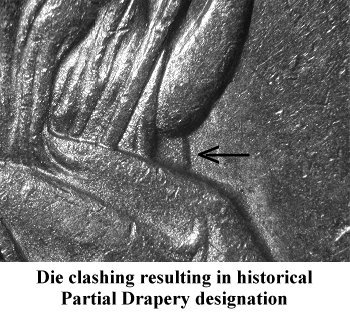
Comments: The 1838 Partial Drapery variety has nothing to do with a partial drapery design but rather is a die clash artifact under Liberty's right elbow. How and why this variety was listed in the Redbook as a partial drapery is not understood but we live with precedence in our hobby. Seeing the die clash mark under Liberty's elbow can be difficult on lower grade examples. I tend to use the reverse to locate 1838 Partial Drapery specimens since the die clashing is really bold through the E in DIME. You can click here to see the web-book 1838 F-108a page for more details.
Reverse of 1838 vs. 1839
1839 Obverse (Huge O) 1839 Obverse (Large O)
Comments: Separating Huge O (Reverse of 1838) from Large O (Reverse of 1839) should not be too difficult with a little practice. The Huge O reverse is left over and worn from striking a considerable number of dimes in 1838. During 1839 coinage, the Huge O reverse is paired with a weak 1839 obverse die with the weakness first noted at the date and Stars 1-3. This obverse is polished and becomes weaker with usage. Therefore collectors and dealers have attribution points on both the obverse and reverse to flag a Huge O (Reverse of 1838) variety. In lower grades of Good through Fine, the variety can be located with searching but becomes really difficult in original VF condition. Locating this variety in EF or better condition is a significant challenge and problem free original specimens will command a large premium above what Coin Values is publishing.
With Drapery vs. No Drapery
With Drapery Obverse No Drapery Obverse
Comments: I cannot remember seeing eBay listings for 1840 No Drapery dimes mistakenly listed as With Drapery and vice versa. The difference between the two varieties is a complete change of the obverse hub design coupled with a reverse hub design change in parallel.
Large O Closed Bud vs. Medium O Open Bud Reverse
Large O Closed Bud Reverse Medium O Open Bud Reverse
Comments: Every early date collector dreams of cherry picking either an 1841-O Large O Closed Bud (above) or Small O Closed Bud (next variety). A collector should have no difficulty with properly identifying an 1841-O Large O Closed Bud dime since there were no other 1841-O dimes struck with a Large O reverse that year! The Large O reverse is left over from 1840 production and is already well worn. In the illustration above, one of the two 1841-O Medium O reverse dies are compared with the Large O reverse. For confirmation, the reverse die hub designs are difference (closed vs. open buds) and one can easily use the position of the lower left wreath leaf with respect to U in UNITED as verification.
Small O Closed Bud vs. Small O Open Bud Reverse
Small O Closed Bud Reverse Small O Open Bud Reverse
Comments: Identification of an 1841-O Small O Closed Bud is much tougher than for the Large O (as discussed above). The Small O reverse is also a left over die from 1840 production and is worn but the mintmark size is the same as many other Open Bud reverse dies used in 1841. Collectors must have knowledge of the reverse hub design differences (closed vs. open bud) and in particular, use the position of the lower left wreath leaf with respect to U in UNITED as verification. Also on many low grade 1841-O Small O Closed Buds, the reverse will be heavily worn down due to a late die state die bulge.
Large Date vs. Small Date
Large Date Punch Small Date Punch
Comments: Mistaking 1856 Large and Small date varieties is really difficult to do since the difference in the date punch sizes is very obvious.
Type I Obverse vs. Type II Obverse
Type I Obverse Type II Obverse
Comments: Distinguishing 1861 Type I and Type II obverse dies takes practice for the casual collector of Liberty Seated dimes. The Type I obverse hub design was only used in 1860 and for a small portion of 1861 coinage. The guidebooks will point collectors to the difference in the shield stripes and Liberty's hand/finger position on the left side of the shield. To be honest, I don't use this attribution approach and have trained my eye to recognize the obvious differences in Liberty's body shape on the two difference obverse hubs. On Type I obverses, Liberty is a bit more full figured but appears to have been on the low carb diet on the Type II obverse.
Short Flag vs. Long Flag Obverse
Short Flag 1 Digit Obverse Long Flag 1 Digit Obverse
Comments: The 1869 date comes with two different date punch styles that have been called Short Flag and Long Flag while refering to the 1 digit punch style in the date. The difference is quite obvious once collector or dealer are aware of the two date punch styles. The Short Flag date punch is used on at least five obverse dies but dimes struck from these dies are always found in low circulated grades. The Long Flag date punch is only used on two obverse dies but nearly all high grade business strikes and proofs will be found with Long Flag dates.
Closed vs. Open 3 Obverse
Closed 3 Obverse Open 3 Obverse
Comments: Distinguishing 1873 Closed 3 and Open 3 varieties does take some practice. Just remember that in 1873, the public and mint officials were unhappy with the fact that the Closed 3 digit looked more like an 8 digit due to the large balls at the end of the left side loops. The Open 3 has a more pronouced 3 digit appearance.
Type I vs. Type II Reverse Hubs
Type I Reverse Type II Reverse
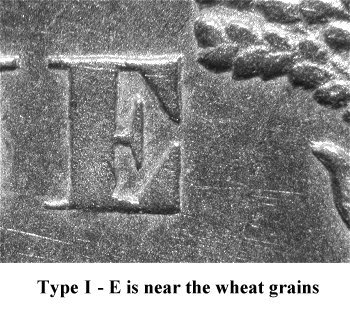
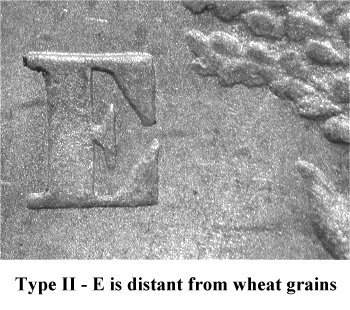
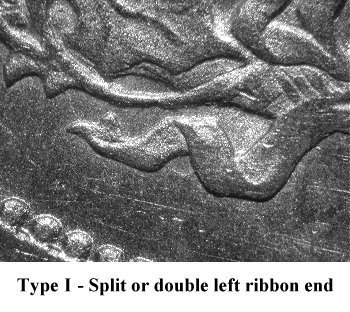
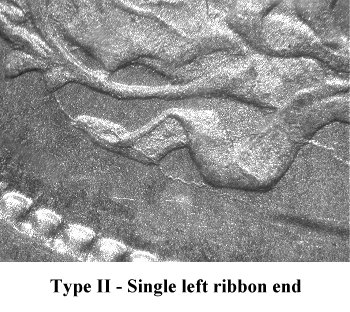
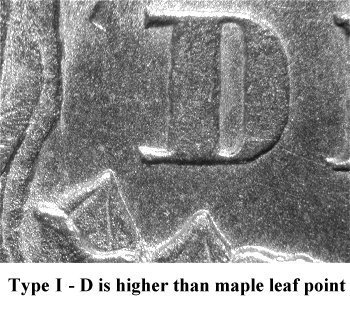
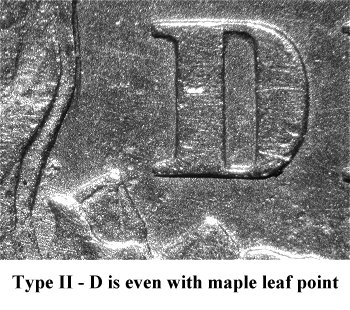
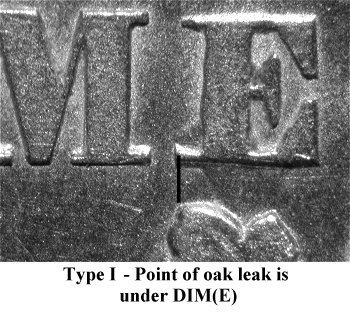
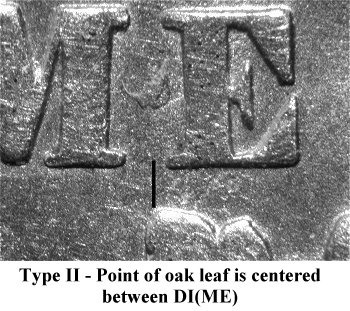
Comments: In the above images, I have listed four obvious differences between the Type I and Type II reverse hubs. The most common two diagnostic methods are the distant between the E in ONE to the wheat grains and the different styles of the left ribbon end. On Type I reverse hub, the E in ONE is very closed to the wheat grains and the left ribbon end has two points. For Type II reverse hub, the opposite is true where the E in ONE is further away from the wheat grains and the left ribbon end has a single point. In addition, the height of the D in DIME with respect to a maple leaf point is also a good diagnostic as is the position of the E in DIME referenced to the oak leaf point directly below the letter. It becomes a matter of personal preference as to which diagnostic method a collector uses to differentiate the two reverse hub styles.
Medium vs. Small S Reverse
Medium S Reverse Small S Reverse
Comments: The difference in mintmark size between the Medium S and the Small S is quite substantial. Collectors should be able to distinguish the two difference mintmark sizes and shapes without much effort. There are only two 1890-S Small S reverse dies as compared to at least twelve Medium S reverses. Therefore the Small S is quite scarce and will command a premium.